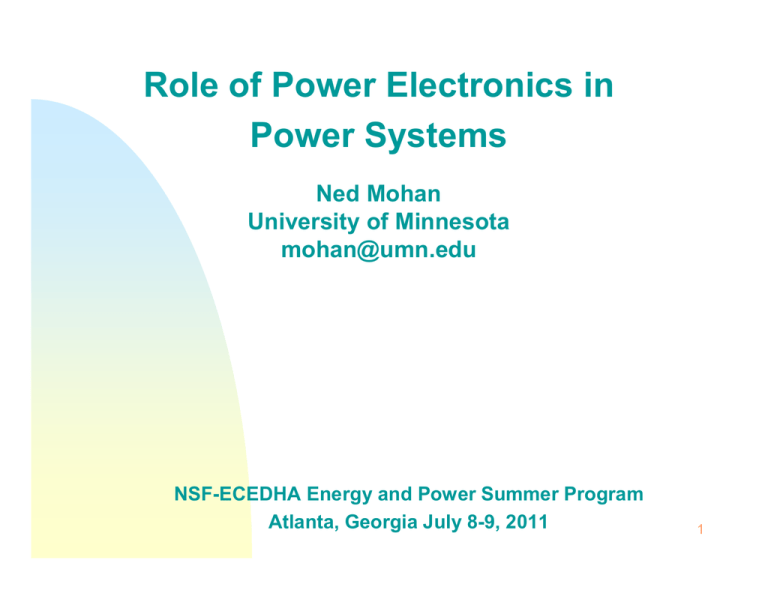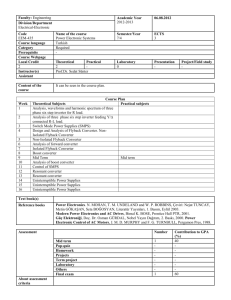A v - ecedha
advertisement

Role of Power Electronics in Power Systems Ned Mohan University of Minnesota mohan@umn.edu NSF-ECEDHA Energy and Power Summer Program Atlanta, Georgia July 8-9, 2011 1 Power-Related Courses Energy, Environment and Society (3cr) Power Systems (3cr) Lab (1cr) Power Systems (3cr) Power Electronics (3cr) Lab (1cr) Freshman Electric Drives (3cr) Lab (1cr) Junior/ Senior Senior Design Project(3cr) Senior Power Electronics (3cr) 1st Year Graduate Electric Drives (3cr) Advanced Graduate Courses 2 Role of Power Electronics in Power Systems • • • Generation Delivery Efficient End-Use 3 Utilities Tomorrow versus Yesterday Storage EV 4 Power Electronics: An Enabling Technology Power Electronics Interface Converter Source Load Controller 5 Device current [A] Continuing Evolution of Power Semiconductor Devices 104 Traction 103 102 101 HVDC FACTS Motor Drive Power Supply Automotive Lighting 100 101 102 103 104 Device blocking voltage [V] (a ) ( b) 6 Controller ICs and Integrated Power Modules: 7 Potentially Lower Cost Power Semiconductor Price Copper and Steel Prices - Copper prices have gone up five fold in three years USD/A 0.7 1200 V IGBTs 0.6 0.5 0.4 0.3 0.2 0.1 0 1990 1995 2000 2005 8 DOE Wind Research Consortium at UMN Improving Reliability and Reducing the Nacelle Weight by 20% Open-end Open-end winding windingac ac machine machine MC MC System System 20 Utility Utility 20 20 1800 High Highfrequency frequencytransformer transformer converter convertersystem system 1800 1800 High-Frequency High-Frequency Transformer Transformer and and Converter Converter Stray Currents due to Converter Switchings cause Damage to Bearings Heavy Cables 80-100 m Light Light Cable Cable at at 34.5 34.5kV kV Power Electronics Converter with Large Storage Capacitors Converter 161kV 690V, 60-Hz 34.5 kV, 60-Hz Underground Heavy Transformer 34.5 34.5 kV, kV, 60-Hz 60-Hz Underground Underground 690V 690V 690V 690V 60Hz 9 GE 1.5 MW Turbine m/s 1 m / s 2.25 miles / hr Source: 10 Power from the Wind Source: 11 Role of Power Electronics in Wind Power Electronics Interface Gen Conv1 Conv 2 Utility 12 13 Sodium Sulfur Battery Storage to Enable Further Integration of Wind (Xcel Energy) 14 High Voltage DC Transmission – HVDC (Current-Link) AC1 AC2 15 HVDC (Voltage-Link) 16 Flexible AC Transmission Systems: FACTS E1∠0 E2 ∠ − δ jX AC1 E1 E2 sin δ P= X AC2 Control of X: (a ) ( b) 17 Voltage Control: jX Utility STATCOM (a ) (b) (c ) Unified Control: sub-station E1 I - E3 + E2 E2 1 2 E1 Shunt converter E3 (b) Series converter P2 , Q2 P1 , Q1 (a) 18 Efficient End-Use Electric Drive Lighting 19% Fixed form IT 14% Power Processing Unit (PPU) Motor Adjustable Form Electric Source (utility) speed / position Sensor s Power Signal Controller HVAC 16% Load Motors 51% Input command (speed / position) Adjustable Speed Drives Figure 1-3 Block diagram of an electric drive system. EV 19 Principle of Operation conv1 conv2 utility Load controller 20 Step-Down (Buck) Converter Filter Vin A + Vo vA − d= Tup Ts vA vA V A = Vo V A = Vo = dVin 21 Realizing a Bi-Positional Switch in A Step-Down Converter q =1 iL + iL Vin + Vo − − ) q (a) + iL Vin − qA = 1 (b) + + Vo − iL + Vo − Vin − qA = 0 (c) 22 Step-Up (Boost) Converter iL Vo C q vL Vin p 23 Bi-Directional Power Flow Buck Boost V1 iL A + vA − + V2 − q q − = (1 − q ) 24 Synthesizing Sinusoidal AC: q =1 ) iL q vaN Vd 0 vaN vaN 0 0 vaN ωt Ts 25 Average Representation of the Switching Power-Pole vaN = d aVd ida = d a ia ida ida + a Vd + ia ia + Vd vaN vaN − − − N 1: d a (a) (b) qa 26 Three-Phase Inverters + a b Vd n c − qa N qb a b c + Vd − qc N 1: d a (a ) 1: d b ( b) 1: d c 27 Interface for Wind Generator va (t ) ia (t ) − + AC motor i A (t ) + e A (t )− A + − B n Vd C N mot motoring Vd v AN v An 1 Vd 2 0 ωt 28 + SV-PWM ia a ib b Vd c ic +v b vc + −v + a 2 vsa (t ) = Vd ( qa e j 0 + qbe j 2π / 3 + qc e j 4π / 3 ) Basic Voltage Vectors − N qa qb qc Figure 7-1 Switch-mode inverter. 2 v2 (010) 2 v3 (011) sector 2 2 vs sector 3 2 v6 (110) sector 1 2 v1 (001) sector 4 sector 6 a -axis 2 2 vsa (000) = v0 = 0 2 2 vsa (001) = v1 = Vd e j 0 2 2 vsa (010) = v2 = Vd e j 2π / 3 2 2 vsa (011) = v3 = Vd e jπ / 3 2 2 vsa (100) = v4 = Vd e j 4π / 3 2 2 vsa (101) = v5 = Vd e j 5π / 3 2 2 vsa (110) = v6 = Vd e jπ 2 2 vsa (111) = v7 = 0 sector 5 2 v4 (100) 2 v5 (101) 29 30 Courses Developed - Fundamentals-based; integrated - Using commonality, in-depth coverage of more topics - Supported by state-of-the-art laboratories P ow er E lectron ics P ow er S ystem s E lectric D rives Bus-1 Features: 1 1 1 S w itching P ow er-P ole as the B uilding-Block Includes dc-dc C onverters and dc-ac Inverters Feedback control of C onverters Teaching M achines as a subcom ponent of Drive System s B us-2 Pe 2 fixe d fo rm Power Processing U nit (PPU) M otor Load Pm 2 speed / po si tion a djus ta bl e for m Elec tric Source (utility) Sensors m e asure d sp ee d / p o siti on Controller inpu t com m and (spe ed / po sition) P owe r S ign al A pplications: - H arnessing of W ind Energy - E lectric and H ybrid-Electric V ehicles S lides S olutions m anual Includes Topics such as - - Slides Solutions m anual D S P -C ontrolled Lab - R enew ables/S torage H VD C , FA C TS V oltage S tability T extbook - Textbook H ardw are Lab - Pe1 E lectric Dri ve T extbook - Pm 1 B us-3 S lides S olutions m anual S oftw are-based Lab : - M A TL A B /S im ulink, Pow erW orld, E M TD C - C om plete Lab on C D - 18 S hort V ideo C lips - 31 12343567879A8B8CDEF 6966C896BD5E6C92DC89D978BD8C79 886C699295DDE559CB9C9 789692! &4'B(9!CCDC9 D84) 19*9B69+841), 1 23456745389 A B3CDEEFC4E84C7456ECE87E 1 3EE9 A E79C74C7C584EC3EC78C78EC7C 5E C3858EC38EF4C!5"CA "#99F89$DC78 A #5879C5C78C36ECE73$CE58 35E84E$C3E74C3FE8E8ECF3EC58C7C 3F%C&5DECA %"#99F89$DC78 A 3479C3858EC3E3DCF3EC38C585657C 75%C7EC38C233EC %"#99F89$DC78 32 Increasing Student Enrollments 33 CUSP™ (www.doeconsortium.ece.umn.edu/cusp) 34
